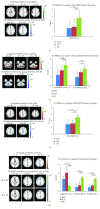Functional Connectivity Alterations in Children with Spastic and Dyskinetic Cerebral Palsy
- PMID: 30186320
- PMCID: PMC6114065
- DOI: 10.1155/2018/7058953
Functional Connectivity Alterations in Children with Spastic and Dyskinetic Cerebral Palsy
Abstract
Cerebral palsy (CP) has long been investigated to be associated with a range of motor and cognitive dysfunction. As the two most common CP subtypes, spastic cerebral palsy (SCP) and dyskinetic cerebral palsy (DCP) may share common and distinct elements in their pathophysiology. However, the common and distinct dysfunctional characteristics between SCP and DCP on the brain network level are less known. This study aims to detect the alteration of brain functional connectivity in children with SCP and DCP based on resting-state functional MRI (fMRI). Resting-state networks (RSNs) were established based on the independent component analysis (ICA), and the functional network connectivity (FNC) was performed on the fMRI data from 16 DCP, 18 bilateral SCP, and 18 healthy children. Compared with healthy controls, altered functional connectivity within the cerebellum network, sensorimotor network (SMN), left frontoparietal network (LFPN), and salience network (SN) were found in DCP and SCP groups. Furthermore, the disconnections of the FNC consistently focused on the visual pathway; covariance of the default mode network (DMN) with other networks was observed both in DCP and SCP groups, while the DCP group had a distinct connectivity abnormality in motor pathway and self-referential processing-related connections. Correlations between the functional disconnection and the motor-related clinical measurement in children with CP were also found. These findings indicate functional connectivity impairment and altered integration widely exist in children with CP, suggesting that the abnormal functional connectivity is a pathophysiological mechanism of motor and cognitive dysfunction of CP.
Figures




Similar articles
-
Aberrant Interhemispheric Functional Organization in Children with Dyskinetic Cerebral Palsy.Biomed Res Int. 2019 Mar 18;2019:4362539. doi: 10.1155/2019/4362539. eCollection 2019. Biomed Res Int. 2019. PMID: 31011574 Free PMC article.
-
Whole-brain structural connectivity in dyskinetic cerebral palsy and its association with motor and cognitive function.Hum Brain Mapp. 2017 Sep;38(9):4594-4612. doi: 10.1002/hbm.23686. Epub 2017 Jun 13. Hum Brain Mapp. 2017. PMID: 28608616 Free PMC article.
-
Cortical plasticity after brachial plexus injury and repair: a resting-state functional MRI study.Neurosurg Focus. 2017 Mar;42(3):E14. doi: 10.3171/2016.12.FOCUS16430. Neurosurg Focus. 2017. PMID: 28245732
-
The relationship between neuroimaging and motor outcome in children with cerebral palsy: A systematic review-Part B diffusion imaging and tractography.Res Dev Disabil. 2020 Feb;97:103569. doi: 10.1016/j.ridd.2019.103569. Epub 2019 Dec 31. Res Dev Disabil. 2020. PMID: 31901671
-
Brain structural and functional connectivity and network organization in cerebral palsy: A scoping review.Dev Med Child Neurol. 2023 Sep;65(9):1157-1173. doi: 10.1111/dmcn.15516. Epub 2023 Feb 7. Dev Med Child Neurol. 2023. PMID: 36750309
Cited by
-
Reduced functional network connectivity is associated with upper limb dysfunction in acute ischemic brainstem stroke.Brain Imaging Behav. 2022 Apr;16(2):802-810. doi: 10.1007/s11682-021-00554-0. Epub 2021 Sep 29. Brain Imaging Behav. 2022. PMID: 34586538
-
Assessment of cortical activity, functional connectivity, and neuroplasticity in cerebral palsy using functional near-infrared spectroscopy: A scoping review.Dev Med Child Neurol. 2025 Jul;67(7):875-891. doi: 10.1111/dmcn.16238. Epub 2025 Feb 18. Dev Med Child Neurol. 2025. PMID: 39963963 Free PMC article.
-
Disrupted functional network connectivity predicts cognitive impairment after acute mild traumatic brain injury.CNS Neurosci Ther. 2020 Oct;26(10):1083-1091. doi: 10.1111/cns.13430. Epub 2020 Jun 25. CNS Neurosci Ther. 2020. PMID: 32588522 Free PMC article.
-
Disrupted intra- and inter-network connectivity in unilateral acute tinnitus with hearing loss.Front Aging Neurosci. 2022 Aug 1;14:833437. doi: 10.3389/fnagi.2022.833437. eCollection 2022. Front Aging Neurosci. 2022. PMID: 35978951 Free PMC article.
-
Functional Connectivity Relationships to Longitudinal Motor Outcomes Differ in Very Preterm Children With and Without Brain Injury.Neurol Clin Pract. 2025 Feb;15(1):e200397. doi: 10.1212/CPJ.0000000000200397. Epub 2024 Oct 18. Neurol Clin Pract. 2025. PMID: 39439574
References
-
- Rosenbaum P. The definition and classification of cerebral palsy: are we any further ahead in 2006? NeoReviews. 2006;7(11):e569–e574. doi: 10.1542/neo.7-11-e569. - DOI
-
- Tomlin P. I. The StaticEncephalopathies. London: Times-Wolfe International; 1995.
Publication types
MeSH terms
LinkOut - more resources
Full Text Sources
Other Literature Sources
Medical
Research Materials
Miscellaneous

